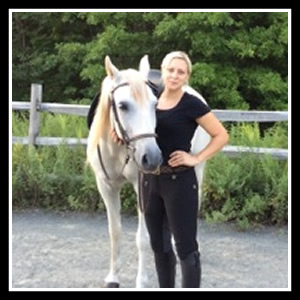Zoolander Working Trot

Good morning this is Will Faerber from Art2Ride and I am here with my wife Karen and our project horse Zoolander. Zoolander is developing quite nicely across the topline and stretching into the contact, so today we are going to show you what it’s like to bring the horse up and find how high we can develop the working trot before the horse drops it’s back.
We find the horse’s position in the stretch and then all you have to do is simply bring the poll up as high as you can without the horse losing it’s back, that is what the rider’s goal is. This will tell you what the horse is ready to do because it will drop it’s back if you bring it up too high. Then we are going to try a little sitting trot to see if he is ready for that. Karen is slowly going to bring him up trying to maintain that position and bring his poll up. This horse had been broken in the third vertebrae so we have to be very careful as we bring him up that he doesn’t just flex in the neck. As you see in the video, that is quite good right there!
Now we try a little sitting trot on him. We will introduce that to find if he can sustain the rhythm. He lost it for a moment there but he is able to do it, very nice! Now we see him get a little broken over in the neck, so she is going to let him stretch back out again. Those are the things we have to be very cautious about when we re-train these horses that have had been over-flexed in the third vertebrae of the neck. We have to be very careful as we bring them up because they will break over in that neck reestablishing that problem. It takes quite a while of careful work to get rid of that break in the neck as we let those ligaments shorten and redevelop correctly.
Now she is going to bring him back up again. Let’s find the highest he can come in the working trot without losing the back. You will see that point in the video, very nice! Now she will try to bring him up a little higher to show you what happens. Zoolander loses the back a little so Karen needs to give him a little boost there. Sometimes we have to test the waters there a little bit, it’s not to say that we don’t correct them, but if they don’t take an easy correction than we are going to go back and stretch them again.
Now she is going to sit to the trot again to see if he can sustain it. That time it was very nice as she was able to make the transition into the sitting trot and his back stayed swinging with no change in the stride. The most important thing is that you learn to ride a real trot when you learn to sit to the trot. So many people today, the trainers allow the horses to slow down to just a crawl with a hollow back just to sit to the trot, but that doesn’t teach you anything at all and actually breaks the horse down. When you actually start to work in real gaits, you find that you really don’t know how to ride.
Now she brings him back up one more time bringing him a little higher. You can see that he had a little resistance there but it wasn’t too bad and she was able to keep him in the same frame. Once again she asks him to sit to the trot, she was able to get into the saddle this time with no change of frame or position and he didn’t break in the third vertebrae in the neck, that is what we are looking for! She then brings him right back into the working trot and into the stretch. So you see the short periods of time we do this? With a young horse you should never drop your stirrups and ride them for half an hour at a time, you will destroy their backs. This is one thing you need to remember when you are developing horses, it’s very different if you have an old school master, the Spanish riding school would always say people need to be on lunge lines when they learn to ride, but what they forgot to tell you is you need a fifteen year old school master with ten years of correct work in order to do that on. When you try to do that on a young horse you wind up destroying their back, which has happened to many many horses.
Thanks so much for joining us, this is Will Faerber from Art2Ride and we will see you next time!





Leave a Reply